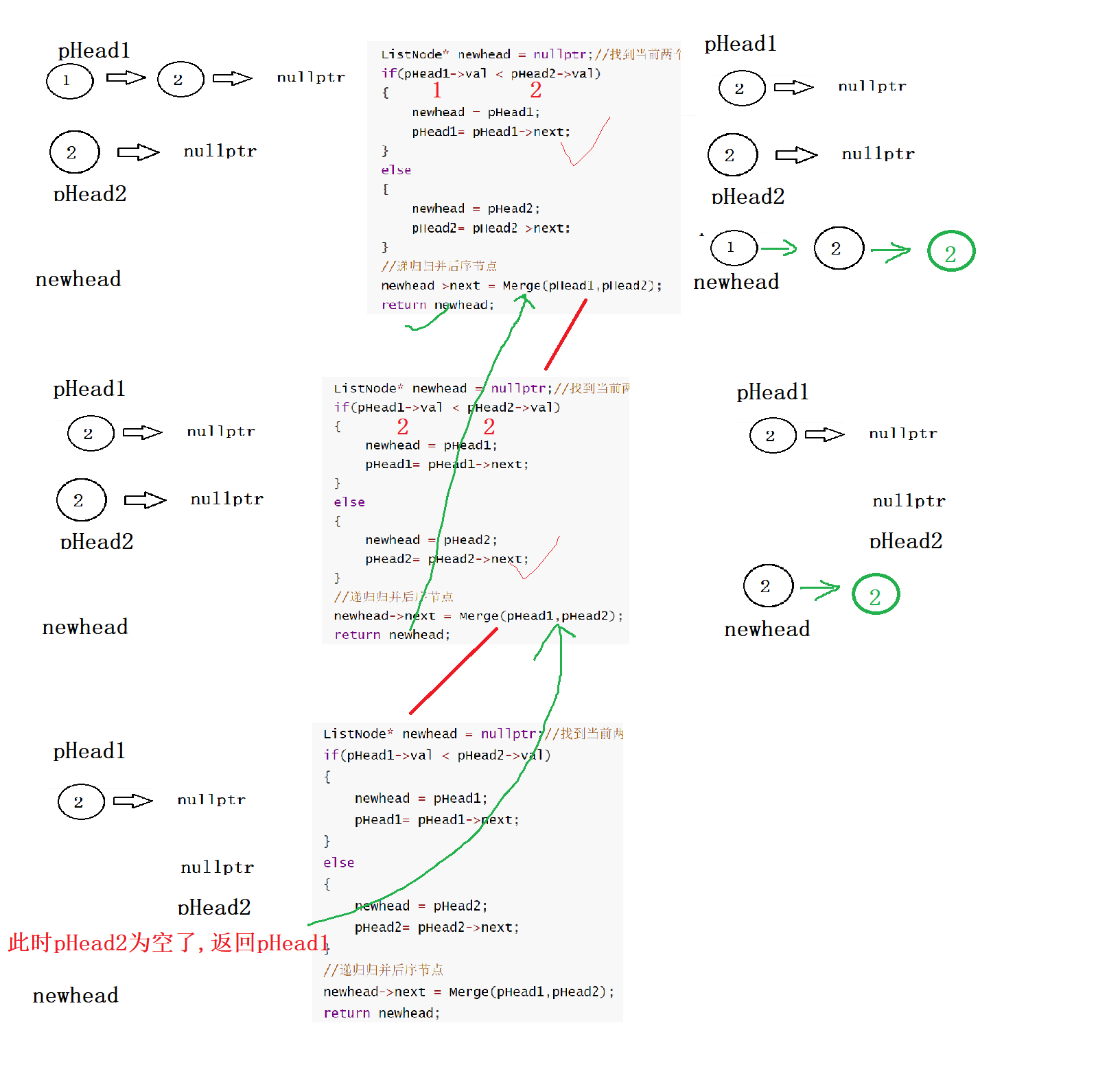反转链表
输入一个链表,反转链表后,输出新链表的表头
https://www.nowcoder.com/practice/75e878df47f24fdc9dc3e400ec6058ca?tpId=13&tqId=11168&rp=1&ru=/ta/coding-interviews&qru=/ta/coding-interviews/question-ranking
方法1:三指针逆置
class Solution {
public:
ListNode* ReverseList(ListNode* pHead) {
//链表为空 || 链表只有一个节点 ->直接返回
if(pHead == nullptr || pHead->next == nullptr)
{
return pHead;
}
//使用三个指针,整体右移,边移动,边翻转,保证不会断链
ListNode* prev = nullptr;
ListNode* next = nullptr;
while(pHead)
{
//prev pHead next链接
next = pHead ->next;//保存下一个节点
pHead ->next = prev;//重新链接
//prev pHead往后走
prev = pHead;
pHead = next;
}
return prev;
}
};
方法2:使用头插法
从原链表中拿到每一个节点插入到新链表的前面,然后更换头指针指向

class Solution {
public:
ListNode* ReverseList(ListNode* pHead) {
//链表为空 || 链表只有一个节点 ->直接返回
if(pHead == nullptr || pHead->next == nullptr)
{
return pHead;
}
ListNode* newHead = nullptr;
while(pHead)
{
ListNode* node = pHead;//把原链表的节点拿下来
pHead = pHead->next;//原链表往后走
//将node头插到新链表
node->next = newHead;//新链表链接该节点
newHead = node;//更换头
}
return newHead;
}
};
有序链表的合并
输入两个单调递增的链表,输出两个链表合成后的链表,当然我们需要合成后的链表满足单调不减规则.
https://www.nowcoder.com/practice/d8b6b4358f774294a89de2a6ac4d9337?tpId=13&tqId=11169&rp=1&ru=/ta/coding-interviews&qru=/ta/coding-interviews/question-ranking
方法1:一个一个节点的归并
class Solution {
public:
ListNode* Merge(ListNode* pHead1, ListNode* pHead2) {
if(pHead1==nullptr && pHead2 == nullptr)
{
return nullptr;
}
if(pHead1 == nullptr) return pHead2;
if(pHead2 == nullptr) return pHead1;
//先选小的作为整条链表的头
ListNode* head = pHead1->val<pHead2->val?pHead1:pHead2;
ListNode* cur1= head==pHead1?pHead1->next:pHead2->next;
ListNode* cur2 = cur1 == pHead1->next?pHead2:pHead1;
ListNode* prev = head;//用于链接节点
//合并
while(cur1&&cur2)
{
if(cur1->val>cur2->val)
{
prev->next = cur2;
prev = prev->next;//prev也要往后走!!!
cur2 =cur2->next;
}
else
{
prev->next = cur1;
prev = prev->next;//prev也要往后走!!!
cur1 =cur1->next;
}
}
//哪条链表没有结束,就让prev链表
if(cur1)
{
prev->next =cur1;
}
if(cur2)
{
prev->next =cur2;
}
return head;
}
};
方法2:递归归并
先对两个链表进行边界判定,一个链表为空,就返回另一个链表,如果两个链表都走到空了,返回nullptr
定义指针newhead, 比较两个链表的头节点,newhead取较小值链表的头节点, 然后小的链表头节点往后走
然后递归链接newhead->next
最后返回newhead

class Solution {
public:
ListNode* Merge(ListNode* pHead1, ListNode* pHead2) {
if(!pHead1&&!pHead2)
{
return nullptr;
}
if(pHead1 == nullptr )
{
return pHead2;
}
if(pHead2 == nullptr)
{
return pHead1;
}
ListNode* newhead = nullptr;//找到当前两个链表中,较小的头节点
if(pHead1->val < pHead2->val)
{
newhead = pHead1;
pHead1= pHead1->next;
}
else
{
newhead = pHead2;
pHead2= pHead2->next;
}
//递归归并后序节点
newhead->next = Merge(pHead1,pHead2);
return newhead;
}
};